How to Use Leading Lines in Photographyالخطوط هي بعض العناصر الأساسية للتصوير الفوتوغرافي، وبعض أبسطها أيضًا. لكن لا تدع هذا يخدعك. تأتي الخطوط في العديد من الأصناف – في بعض الأحيان خطوط تقود التكوين، وفي أحيان أخرى حواجز تقسم الصورة. كما أنها تؤثر أيضًا على الإحساس بالعاطفة والبنية في الصورة. في هذه المقالة، سأغطي أفضل الطرق لاستخدام الخطوط الرائدة والخطوط الأخرى في التصوير الفوتوغرافي، بما في ذلك كيفية وضعها موضع التنفيذ في تركيباتك الخاصة.
جدول المحتويات
كيفية استخدام الخطوط البادئة في التركيب الخاص بكالخطوط توفر هيكلًا للصورة كيفية استخدام الخطوط كحواجز دراسات الحالةكيفية تكوين الخطوط بشكل فعال
Lines are some of the most fundamental elements of photography, and some of the simplest, too. But don’t let that fool you. Lines come in many varieties – sometimes leading lines that guide the composition, other times barriers segmenting a photo. They also impact an image’s sense of emotion and structure. In this article, I will cover the best ways to use leading lines and other lines in photography, including how to put them into practice in your own compositions.
Table of Contents
- How to Use Leading Lines in Your Composition
- Lines Provide Structure to a Photo
- How to Use Lines as Barriers
- Case Studies
- How to Compose Lines Effectively
-
كيفية استخدام الخطوط الرائدة في تكوينك
التأثير الأكثر وضوحًا للخطوط هو أنها توجه عين المشاهد. فهي تشير من منطقة في الصورة إلى أخرى، وغالبًا من المقدمة إلى الخلفية. لهذا السبب ربما سمعت عن “الخطوط البادئة” من قبل – الخطوط التي تكتسح الصورة وتجعلها أكثر ترابطًا.
بعض الخطوط الرئيسية الأكثر شيوعًا هي الطرق والأسوار والأنهار والأودية وما إلى ذلك. إنها تمتد فعليًا عبر الفضاء، ولا توفر فقط رابطًا تركيبيًا من المقدمة إلى الخلفية، ولكنها أيضًا تنشئ المسار الفعلي الذي ستتبعه للوصول إلى هناك في العالم الحقيقي. هذا هو السبب في أنها قوية جدًا في التكوين. إنها تمنح المشاهد مسارًا حرفيًا للغاية لمتابعة الصورة.
كاميرا نيكون D800E + 14-24 مم f/2.8 @ 14 مم، ISO 100، 1/13، f/16.0
How to Use Leading Lines in Your Composition
The most obvious effect of lines is that they guide a viewer’s eye. They point from one area of the photo to another, often from the foreground to the background. This is why you’ve probably heard of “leading lines” before – lines that sweep through the photo and make it more interconnected.
Some of the most common leading lines are roads, fences, rivers, canyons, and so on. They physically stretch through space, not just providing a compositional link from foreground to background, but also creating the actual route you’d follow to get there in the real world. This is why they’re so powerful in composition. They give the viewer a very literal trail to follow through an image.
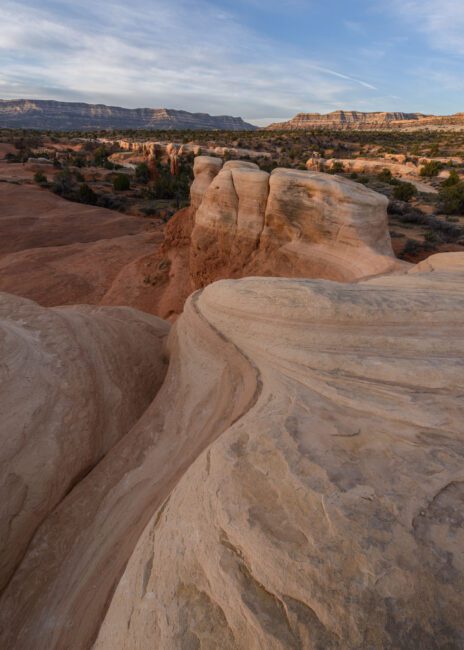 NIKON D800E + 14-24mm f/2.8 @ 14mm, ISO 100, 1/13, f/16.0هناك عدة طرق لاستخدام الخطوط البادئة عند إنشاء صورة. أولاً، يمكنك جعلها الموضوع الأساسي لصورتك، حيث تشغل مساحة كبيرة وتجذب مستويات عالية من الاهتمام. الصورة أعلاه هي أحد الأمثلة. للقيام بذلك، تحتاج عمومًا إلى الاقتراب كثيرًا من الخط الرائد في العالم الحقيقي. غالبًا ما يساعد استخدام عدسة ذات زاوية واسعة لتضخيم حجمها مقارنة بالخلفية.
NIKON D800E + 14-24mm f/2.8 @ 14mm, ISO 100, 1/13, f/16.0هناك عدة طرق لاستخدام الخطوط البادئة عند إنشاء صورة. أولاً، يمكنك جعلها الموضوع الأساسي لصورتك، حيث تشغل مساحة كبيرة وتجذب مستويات عالية من الاهتمام. الصورة أعلاه هي أحد الأمثلة. للقيام بذلك، تحتاج عمومًا إلى الاقتراب كثيرًا من الخط الرائد في العالم الحقيقي. غالبًا ما يساعد استخدام عدسة ذات زاوية واسعة لتضخيم حجمها مقارنة بالخلفية.ومع ذلك، يمكن أن تكون الخطوط الرئيسية عناصر أكثر دقة في التركيب أيضًا. ألقِ نظرة على الصورة أدناه، والتي من الواضح أنها تحتوي على خط أمامي – ممر المشاة في الأسفل – ولكنه لا يهيمن عليه. لا يزال هذا يعتبر خطًا بادئًا لأنه يوفر مسارًا للمشاهدين للمتابعة من جزء من الصورة إلى آخر. ولكنه يوضح أيضًا أنه حتى العناصر الصغيرة في التركيبة يمكن أن تلعب دورًا مماثلاً:
كاميرا نيكون D800E + 20 مم f/1.8 @ 20 مم، ISO 100، 1/80، f/16.0
لا يلزم دائمًا أن تكون الخطوط الرائدة مسارات يمكنك اتباعها فعليًا، سواء من صنع الإنسان أو غير ذلك. في بعض الأحيان، تكون مجرد أنماط على الأرض، أو أشكال في السماء، توجه عين المشاهد بالرغم من ذلك. قد يكون من الصعب التمييز بين الخطوط الرائدة والخطوط ببساطة. يمكن لفرع شجرة يمتد من اليسار إلى اليمين أن يرشد تكوينك، وكذلك الأمر بالنسبة لذراعي شخصين عندما يمسكان بأيديهما.
لذلك، يتعمق القسم التالي في الاستخدامات المهمة الأخرى للخطوط في التصوير الفوتوغرافي، سواء كانت تعتبر “رائدة” أم لا.
There are a few ways to use leading lines when you are composing a photo. First, you can make them the primary subject of your photo, taking up a lot of space and attracting high levels of attention. The image above is one example. To do this, you generally need to get very close to the leading line in the real world. It often helps to use a wide angle lens to exaggerate its size compared to the background.
However, leading lines can be more subtle elements of composition, too. Take a look at the photo below, which clearly has a leading line – the footpath at the bottom – yet isn’t dominated by it. This still counts as a leading line because it provides a path for viewers to follow from one part of the image to another. But it also demonstrates that even small elements in the composition can fill a similar role:
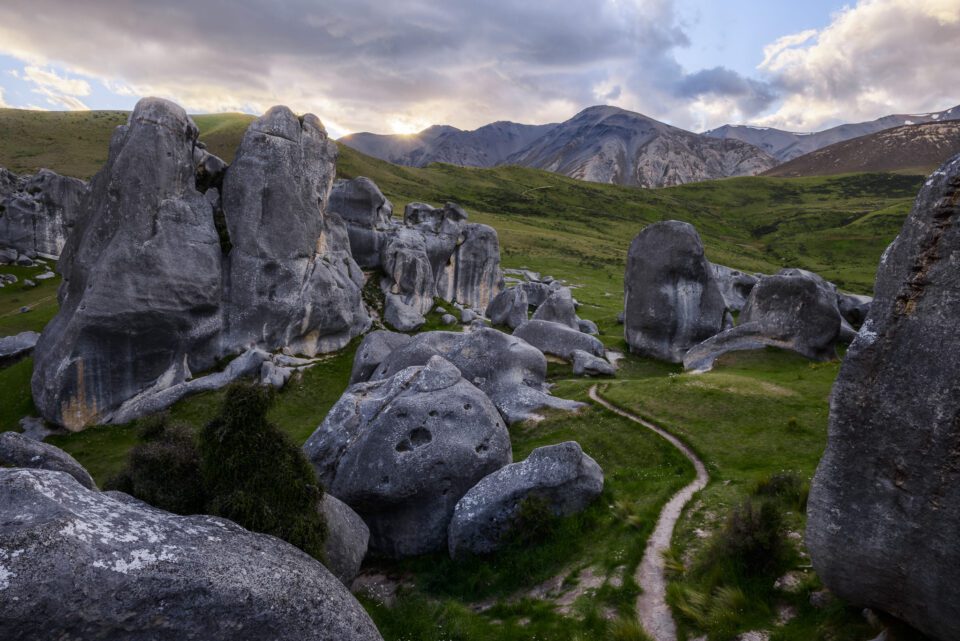 NIKON D800E + 20mm f/1.8 @ 20mm, ISO 100, 1/80, f/16.0
NIKON D800E + 20mm f/1.8 @ 20mm, ISO 100, 1/80, f/16.0
Leading lines don’t always need to be paths that you could actually follow, manmade or otherwise. Sometimes, they’re just patterns on the ground, or shapes in the sky, that guide a viewer’s eye nonetheless. It can be tricky to differentiate between leading lines and, simply, lines. A tree branch spanning from left to right can guide your composition, and so can two people’s arms when they hold hands.So, the next section dives other important uses of lines in photography, whether they count as “leading” or not
توفر الخطوط هيكلًا للصورةالتكوين هو كل شيء عن الهيكل. أنت تقوم بتنظيم عناصر الصورة لتوصيل رسالتك بأكبر قدر ممكن من الفعالية. تعد الخطوط من بين أفضل الأدوات الموجودة في مجموعتك لتحقيق ذلك.
إذا كان الطريق يربط بين مقدمة الصورة وخلفيتها، فهذا يعني أنك قمت للتو بإنشاء بنية تركيبية. إذا أحاطت سحابة بموضوعك وأبقت عين المشاهد متجهة نحو مركز الصورة، فستكون النتيجة نفسها – هيكل لتكوينك.
Lines Provide Structure to a Photo
Composition is all about structure. You’re organizing elements of an image to convey your message as effectively as possible. Lines are among the best tools in your kit to make that happen.
If a road links the foreground and background of a photo, you just created a compositional structure. If a cloud encircles your subject and keeps the viewer’s eye trained to the center of an image, it’s the same result – a structure to your composition.
-
نظرًا لأن الخطوط لديها القدرة على ربط جزأين مختلفين من الصورة (أو أكثر)، فهي إحدى أكثر الطرق الطبيعية لتنظيم تكوينك. على الرغم من أن هذا يأتي أحيانًا بالشكل الكلاسيكي لخط بادئ من المقدمة إلى الخلفية، إلا أنه لا يحدث دائمًا. في الصورة أدناه، تشكل خطوط الوادي شكل قلب مما يعطي هذه التركيبة سببًا للوجود:
© نسيم منصوروف
Because lines have the power to link two different parts of a photo (or more), they’re one of the most natural ways to organize your composition. Although this sometimes comes in the classic form of a leading line from foreground to background, it doesn’t always. In the photo below, the canyon lines form a heart shape that gives this composition a reason to exist:
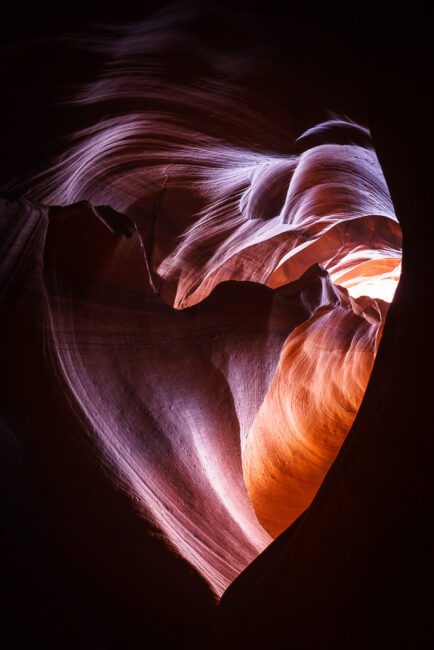 © Nasim Mansurov
© Nasim Mansurov
- تعديل
- اقتباس
- تعليق
- علامة
- معجب0
- Set as Answer
-
وفي حالات أخرى، يكون السطر نفسه هو موضوعك. من المؤكد أن الخطوط هي عناصر بسيطة في التركيب، لكنها لا تزال تحتوي على الكثير من الاهتمام والعاطفة. يحكي الخط المنحني اللطيف قصة مختلفة تمامًا عن الخط الحاد المتعرج. لذلك، فحتى الصورة البسيطة لجبل زاوي مظلل أمام السماء يمكن أن تنقل مشاعر قوية. وينطبق الشيء نفسه على الشكل اللطيف للخط المتعرج في الرمال.
كاميرا نيكون D800E + 70-200 مم f/4 @ 75 مم، ISO 100، 1/8، f/16.0
منتزه غريت ساند ديونز الوطني، كولورادو.ضع في اعتبارك أيضًا أن الخطوط لا تحدد المسارات في الصورة فحسب؛ كما أنها تضع الحدود، كما سترى في القسم التالي.
In other cases, the line itself is your subject. Sure, lines are simple elements of composition, but they still have a lot of interest and emotion. A gentle, curved line tells a very different story from a sharp, jagged line. So, even the simple image of an angular mountain silhouetted against the sky can convey strong emotions. The same is true of the pleasant shape of a winding line in the sand.
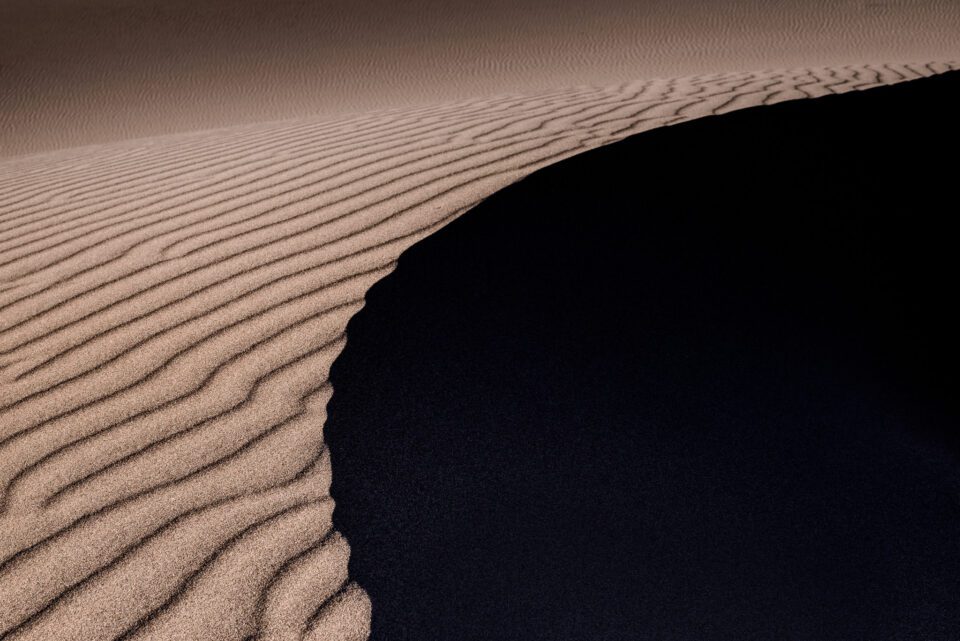 NIKON D800E + 70-200mm f/4 @ 75mm, ISO 100, 1/8, f/16.0
NIKON D800E + 70-200mm f/4 @ 75mm, ISO 100, 1/8, f/16.0
Great Sand Dunes National Park, Colorado.
Also keep in mind that lines don’t only set paths in a photo; they also set boundaries, as you’ll see in the next section.كيفية استخدام الخطوط كحواجزتتمتع العين بوقت سهل للتدفق على طول الخطوط. لديها وقت أصعب بكثير تتدفق عبرها.
يمكن أن تؤدي الآفاق، إذا لم يتم التعامل معها بشكل صحيح، إلى تقسيم الجزء العلوي والسفلي من الصورة بطريقة غير سارة. ولهذا السبب أبحث غالبًا عن آفاق ناعمة، أو الحالات التي يعبر فيها عنصر مختلف بين السماء والأرض لجعلهما يشعران بأنهما أكثر ارتباطًا (على سبيل المثال، صاعقة، أو قوس قزح، أو سحابة – ولاحظ أن كل هذه الأشياء، في حد ذاتها، يمكن أن تكون تعتبر خطوطا رائدة).
الخط الرئيسي من المقدمة إلى الخلفية في هذه الصورة مهم جدًا لتكوينها. وكذلك الأمر بالنسبة لسحابة البخار التي تعبر خط الأفق، والتي لولا ذلك لكانت قد حجبت العين وقسمت هذه الصورة بشكل حاد للغاية من الأعلى إلى الأسفل.
لذا، إذا كنت تريد أن تبدو صورتك بأكملها مترابطة، فإن “الخطوط العازلة” تستحق الاهتمام بها. يمكن للخط الذي يسير في الاتجاه الخاطئ أن يقسم الصورة بدلاً من توصيلها.
How to Use Lines as Barriers
The eye has an easy time flowing along lines. It has a much harder time flowing across them.
Horizons, if not dealt with properly, can divide the top and bottom of a photo in an unpleasant way. It’s why I often look for soft horizons, or cases where a different element crosses between the sky and the land to make them feel more connected (say, a lightning bolt, rainbow, or cloud – and note that all of these, themselves, could be considered leading lines).
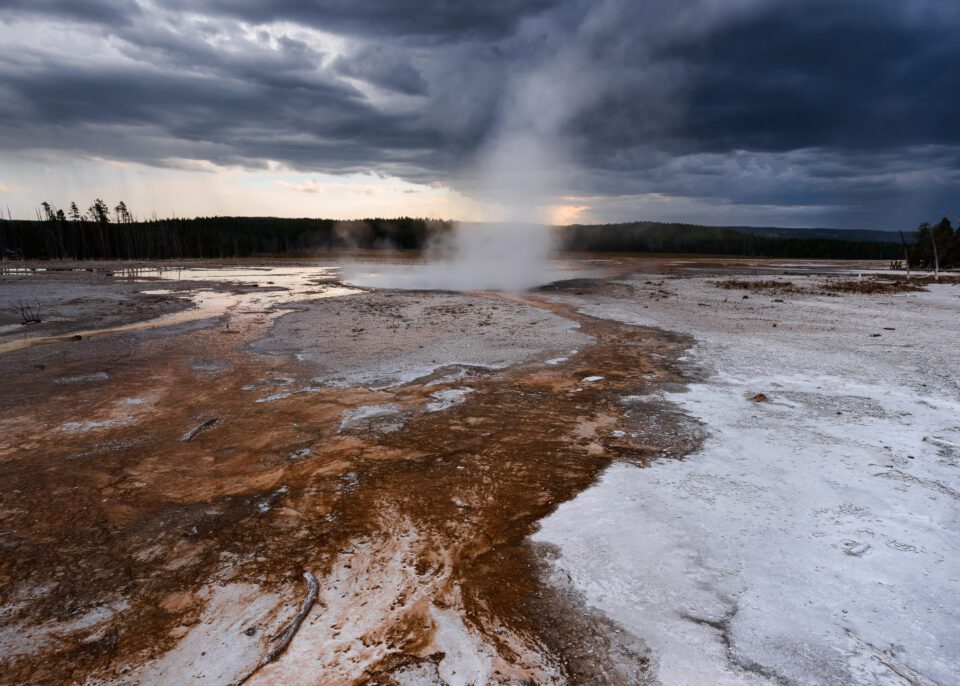 The leading line from the foreground to background in this photo is very important to its composition. So is the cloud of steam that traverses the horizon line – which otherwise would have blocked the eye and divided this photo very sharply from top to bottom.
The leading line from the foreground to background in this photo is very important to its composition. So is the cloud of steam that traverses the horizon line – which otherwise would have blocked the eye and divided this photo very sharply from top to bottom.
So, if you want your entire image to feel interconnected, “barrier lines” are worth paying attention to. A line going the wrong way can divide an image rather than connect it.ثم مرة أخرى، عند استخدامها بشكل صحيح، يمكن أن تكون خاصية الحاجز للخطوط وسيلة فعالة لجعل صورتك تبدو مستقلة ومتعمدة. على سبيل المثال، ابحث عن الإطارات الطبيعية حول المشهد – عناصر مثل الأشجار أو السحب التي تنشئ حواجز بالقرب من حافة الصورة. نظرًا لأن المصورين غالبًا لا يرغبون في إخراج عين المشاهد من الإطار، فإن وضع حاجز يمكن أن يكون وسيلة قوية لاحتواء التكوين الخاص بك أو إغلاقه. تحتوي هذه الصورة على إطار طبيعي بسبب الأشجار الموجودة على اليسار واليمين وكذلك خطوط الصخور الموجودة على الأرض
Then again, used properly, the barrier property of lines can be an effective way to make your photo feel self-contained and deliberate. For example, look for natural framesaround your scene – elements such as trees or clouds that create barriers near the edge of a photo. Because photographers often don’t want to lead the viewer’s eye out of the frame, putting a barrier can be a powerful way to contain or close your composition.
 This photo has a natural frame due to the trees on the left and right, as well as the lines of rocks on the groundدراسات الحالة
This photo has a natural frame due to the trees on the left and right, as well as the lines of rocks on the groundدراسات الحالةوفيما يلي بعض الأمثلة على الخطوط المستخدمة في الصور – من الخطوط الرائدة التقليدية إلى الهياكل التركيبية الأوسع. افحص التركيبات أدناه وانتبه إلى كيفية توجيه الخطوط أو حجب عين المشاهد:
NIKON Z 7 + NIKKOR Z مقاس 24-70 مم f/4 S @ 24 مم، ISO 64، 1.6 ثانية، f/11.0. لاحظ كيف أن الخط الأفقي، الذي كان من الممكن أن يقسم الصورة بقوة شديدة، يصبح ناعمًا ويتلاشى تمامًا على طول الجانب الأيمن.NIKON D800E + 14-24 مم f/2.8 @ 20 مم، ISO 100، 0.8 ثانية، f/16.0 . خط رئيسي واضح تم إنشاؤه بواسطة أنماط المقدمة، وتم تضخيمه باستخدام عدسة واسعة الزاوية.NIKON D800E + 70-200 مم f/4 @ 200 مم، ISO 100، 1/250، f/11.0. غالبًا ما تحتوي الموضوعات ذات الإضاءة الخلفية على خطوط أمامية مدمجة بسبب ظلالها ببساطة.NIKON D800E + 14-24 مم f/2.8 @ 18 مم، ISO 100، 1/60، f/13.0. يكمل السجل المتجمد المشهد المتجمد، مما يجعله خطًا رائدًا طبيعيًا للغاية.NIKON D800E + 70-200 مم f/4 @ 95 مم، ISO 100، 1/40، f/16.0. مثال آخر لكيفية إنشاء الظلال لخطوط في الصورة، رائدة وغير ذلك. تعمل الخطوط أيضًا على تقسيم هذه الصورة إلى نمط رقعة الشطرنج.NIKON D800E + 70-200 مم f/4 @ 86 مم، ISO 100، 1/10، f/16.0. عندما لا تكون صورتك سوى سلسلة من الخطوط، فقد ينتهي بك الأمر إلى التقاط بعض الأنماط المجردة المثيرة للاهتمام للغاية. NIKON Z 7 + NIKKOR Z مقاس 24-70 مم f/4 S @ 24 مم، ISO 64، 1/13، f/16.0. الخط الرئيسي للنهر، بالإضافة إلى إطار طبيعي بفضل الأشجار الموجودة على اليمين واليسار في الأعلى.
Case Studies
Here are some examples of lines used in photos – from traditional leading lines to broader compositional structures. Examine the compositions below and pay attention to how the lines guide or block a viewer’s eye:
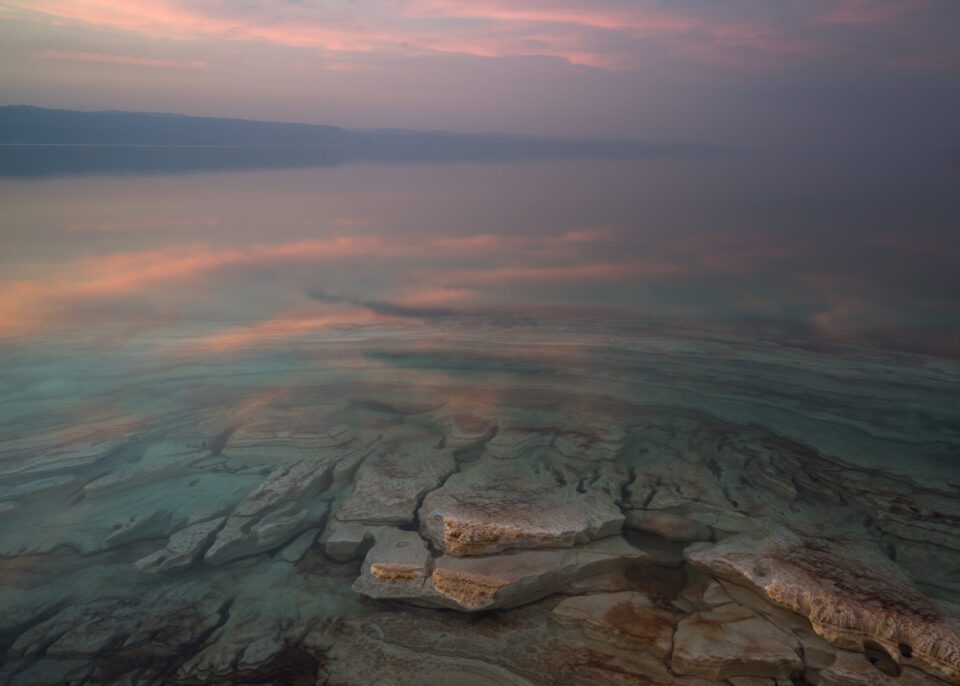 NIKON Z 7 + NIKKOR Z 24-70mm f/4 S @ 24mm, ISO 64, 1.6 seconds, f/11.0. Note how the horizon line, which could have divided the photo very strongly, grows soft and fades away completely along the right-hand side.
NIKON Z 7 + NIKKOR Z 24-70mm f/4 S @ 24mm, ISO 64, 1.6 seconds, f/11.0. Note how the horizon line, which could have divided the photo very strongly, grows soft and fades away completely along the right-hand side.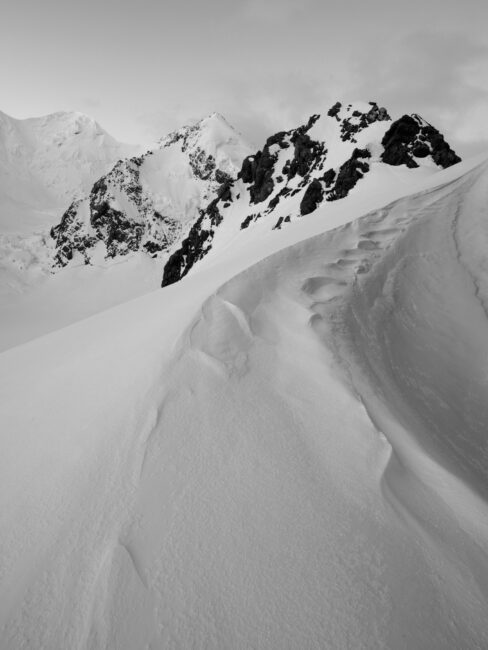 NIKON D800E + 14-24mm f/2.8 @ 20mm, ISO 100, 0.8 seconds, f/16.0. An obvious leading line created by foreground patterns, and exaggerated with the use of a wide-angle lens.
NIKON D800E + 14-24mm f/2.8 @ 20mm, ISO 100, 0.8 seconds, f/16.0. An obvious leading line created by foreground patterns, and exaggerated with the use of a wide-angle lens.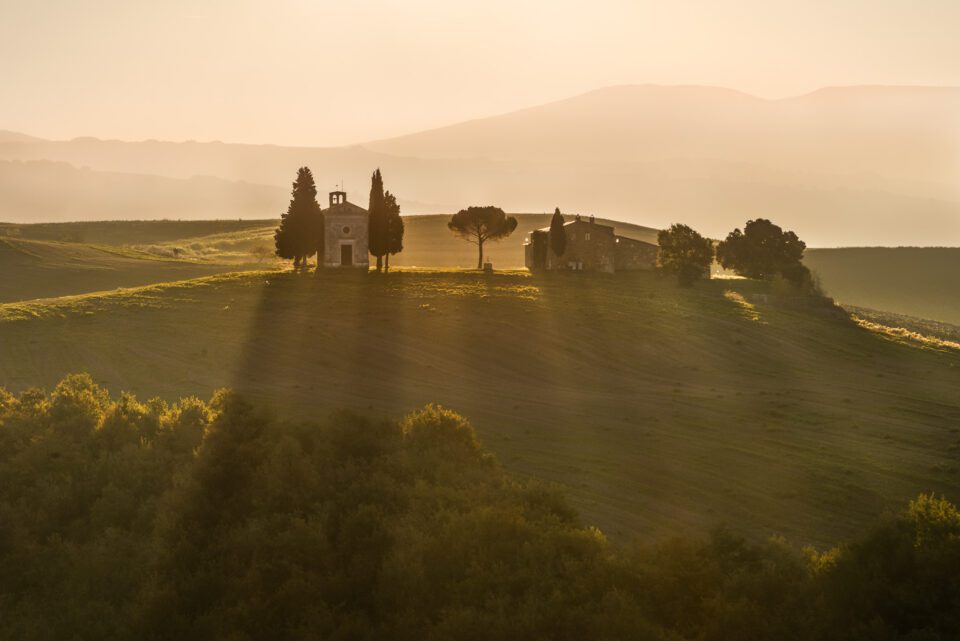 NIKON D800E + 70-200mm f/4 @ 200mm, ISO 100, 1/250, f/11.0. Backlit subjects often have built-in leading lines simply because of their shadows.
NIKON D800E + 70-200mm f/4 @ 200mm, ISO 100, 1/250, f/11.0. Backlit subjects often have built-in leading lines simply because of their shadows.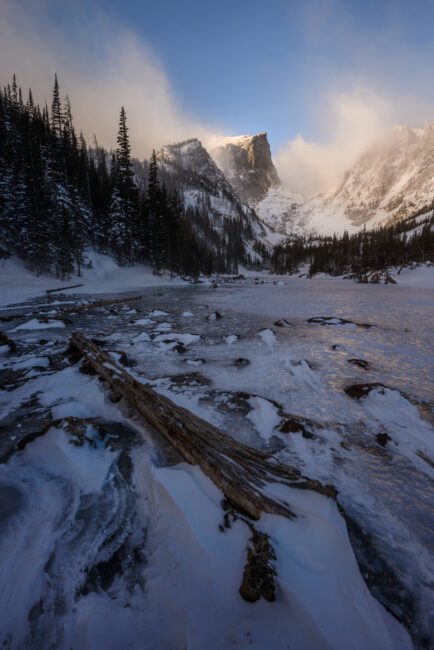 NIKON D800E + 14-24mm f/2.8 @ 18mm, ISO 100, 1/60, f/13.0. The frozen log complements the frozen landscape, making for a very natural leading line.
NIKON D800E + 14-24mm f/2.8 @ 18mm, ISO 100, 1/60, f/13.0. The frozen log complements the frozen landscape, making for a very natural leading line.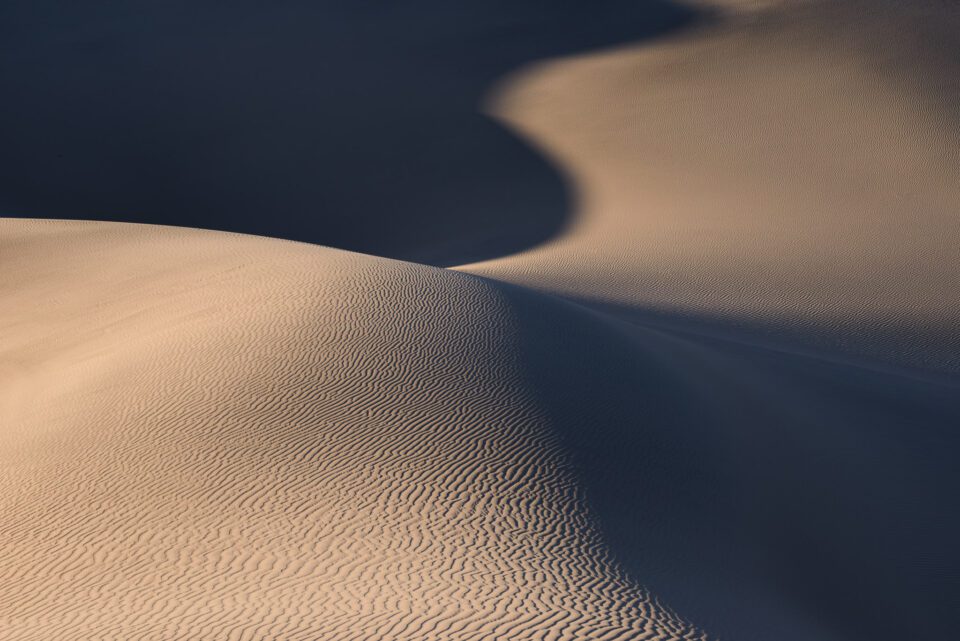 NIKON D800E + 70-200mm f/4 @ 95mm, ISO 100, 1/40, f/16.0. Another example of how shadows can create lines in a photo, leading and otherwise. The lines also segment this image into a checkerboard pattern.
NIKON D800E + 70-200mm f/4 @ 95mm, ISO 100, 1/40, f/16.0. Another example of how shadows can create lines in a photo, leading and otherwise. The lines also segment this image into a checkerboard pattern.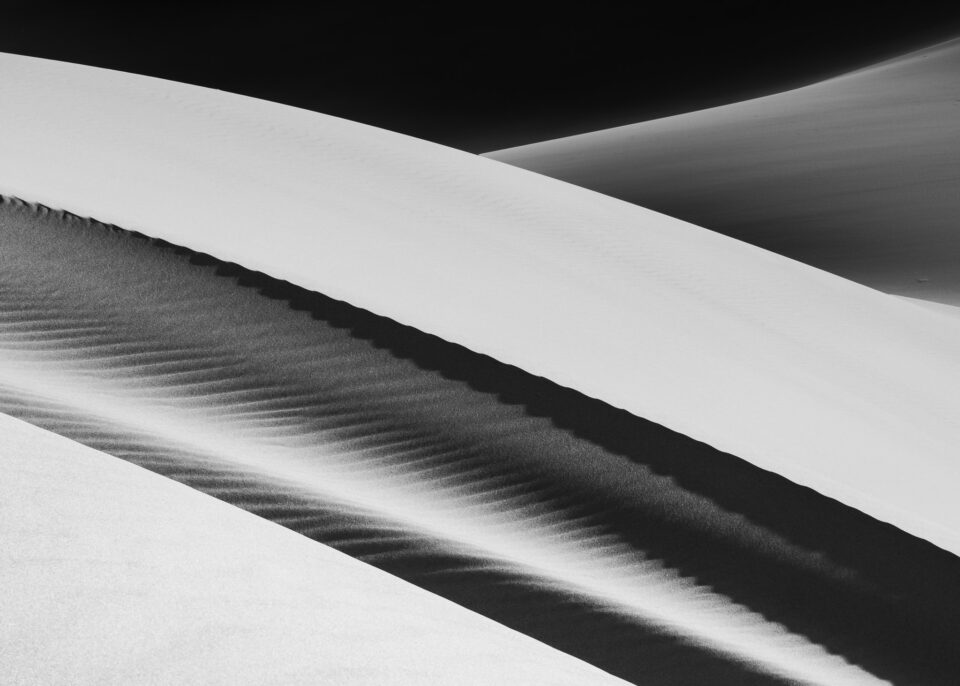 NIKON D800E + 70-200mm f/4 @ 86mm, ISO 100, 1/10, f/16.0. When your photo is nothing but a series of lines, you can end up capturing some very interesting abstract patterns.
NIKON D800E + 70-200mm f/4 @ 86mm, ISO 100, 1/10, f/16.0. When your photo is nothing but a series of lines, you can end up capturing some very interesting abstract patterns.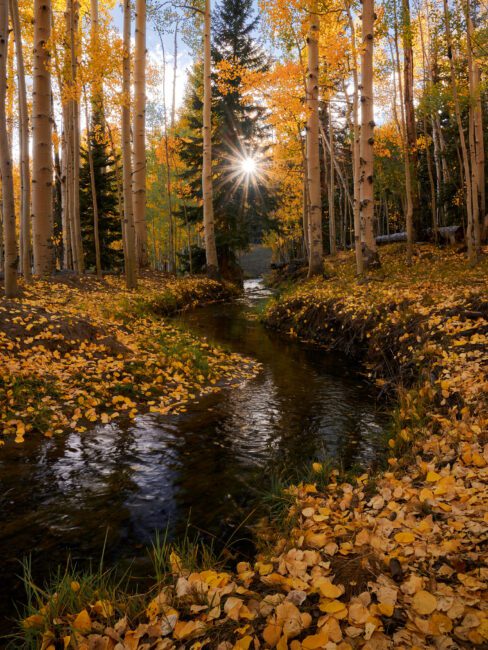 NIKON Z 7 + NIKKOR Z 24-70mm f/4 S @ 24mm, ISO 64, 1/13, f/16.0. The leading line of a river, as well as a natural frame thanks to the trees on the right and left at the top.كما ترون، يمكن لأي شيء تقريبًا إنشاء خط في صورك. إذا كنت تبحث عن سطر بادئ كلاسيكي من المقدمة إلى الخلفية، فإليك بعض الموضوعات الأكثر شيوعًا التي يجب البحث عنها:
NIKON Z 7 + NIKKOR Z 24-70mm f/4 S @ 24mm, ISO 64, 1/13, f/16.0. The leading line of a river, as well as a natural frame thanks to the trees on the right and left at the top.كما ترون، يمكن لأي شيء تقريبًا إنشاء خط في صورك. إذا كنت تبحث عن سطر بادئ كلاسيكي من المقدمة إلى الخلفية، فإليك بعض الموضوعات الأكثر شيوعًا التي يجب البحث عنها:الطرق والمسارات من صنع الإنسانالأنهار وأمواج المحيط والكثبان الرمليةالتكوينات الصخرية والخطوط على الأرضالظلال من الأهداف ذات الإضاءة الخلفيةآثار الأقدام تسير على مسافةالأشجار المتساقطةأنماط في الجليدالأخاديد
والخطوط، بشكل عام، يمكن تشكيلها بطرق أخرى لا تعد ولا تحصى، بما في ذلك:
قوس قزحجذوع الأشجاردرب التبانة في الليلالشلالاتشكل الأشخاصالأعمدة والحواف في الهندسة المعماريةخطوط الأفقالسحبالخطوط الضمنية (مثل شخص ينظر إلى شيء ما)خطوط مبالغ فيها من عدسات واسعة الزاويةالبرقالظلال ذات الحواف الصلبة
إذا كنت تريد استخدام الخطوط كعنصر من عناصر التركيب، فراقب متى ترى هذه المواضيع.
As you can see, almost anything can create a line in your photos. If you’re after a classic foreground-to-background leading line, here are some of the most common subjects to look for:
- Manmade roads and paths
- Rivers and ocean waves
- Sand dunes
- Rock formations and lines on the ground
- Shadows from backlit subjects
- Footprints going into the distance
- Fallen trees
- Patterns in ice
- Canyons
And lines, more generally, can be formed in countless other ways, including:
- Rainbows
- Tree trunks
- The Milky Way at night
- Waterfalls
- The shape of people
- Columns and edges in architecture
- Horizon lines
- Clouds
- Implied lines (like someone looking at an object)
- Exaggerated lines from wide-angle lenses
- Lightning
- Hard-edged shadows
If you want to use lines as an element of composition, keep an eye out whenever you see these subjects.
كيفية تكوين الخطوط بشكل فعالبعد أن وجدت بعض الخطوط المثيرة للاهتمام لتصويرها، أو خطًا رائعًا من الأمام إلى الخلف، كيف تجعلها تبدو جيدة قدر الإمكان في تكوينك؟
الخطوة الأولى هي أن تسأل نفسك ما إذا كان ذلك يساعد الصورة بالفعل. على الرغم من أنه من الجميل ربط المقدمة والخلفية للتركيبة، فلا تجبرها على ذلك. لا تحتاج كل صورة إلى شجرة ساقطة أو مجموعة من آثار الأقدام تتجول في الأفق. في بعض الأحيان، تكون الخطوط أكثر دقة (مثل التمدد الطبيعي لعدسة واسعة الزاوية)، أو حتى غير مهمة على الإطلاق في صورة معينة.
لقد شارك نسيم الصورتين التاليتين من قبل على موقع Photography Life، وهما يوضحان ذلك بشكل مثالي. الصورة الأولى، مع وجود السجل في المقدمة كخط رئيسي، هي في الواقع مشتتة للغاية. الصورة الثانية تبسط التركيب وتكون أقوى بكثير نتيجة لذلك:
نيكون D700 عند 28 مم، ISO 200، 1/320، f/8.0 NIKON D700 + 24-70 مم f/2.8 عند 44 مم، ISO 200، 1/30، f/8.0
How to Compose Lines Effectively
After you’ve found some interesting lines to photograph, or a nice leading line from front to back, how do you make it look as good as possible in your composition?
The first step is to ask yourself if it actually helps the image. Although it’s nice to connect the foreground and background of a composition, don’t force it. Not every photo needs a fallen tree or a set of footprints wandering to the horizon. Sometimes, lines are more subtle (such as the natural stretching of a wide-angle lens), or even not important at all in a given photo.
Nasim has shared the following two images before on Photography Life, and they illustrate this perfectly. The first photo, with the log in the foreground as a leading line, is actually quite distracting. The second image simplifies the composition and is much stronger as a result:
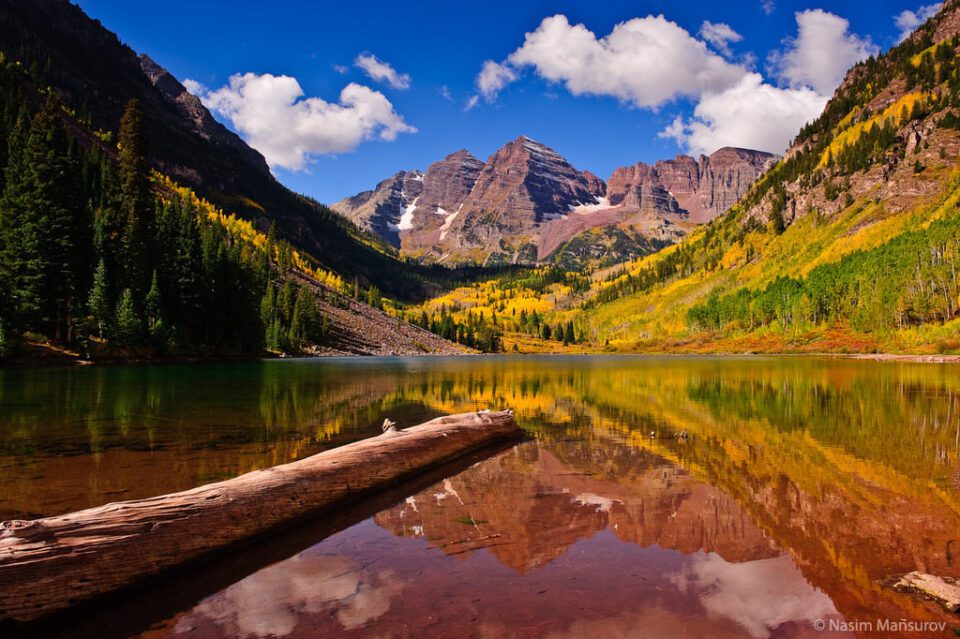 NIKON D700 @ 28mm, ISO 200, 1/320, f/8.0
NIKON D700 @ 28mm, ISO 200, 1/320, f/8.0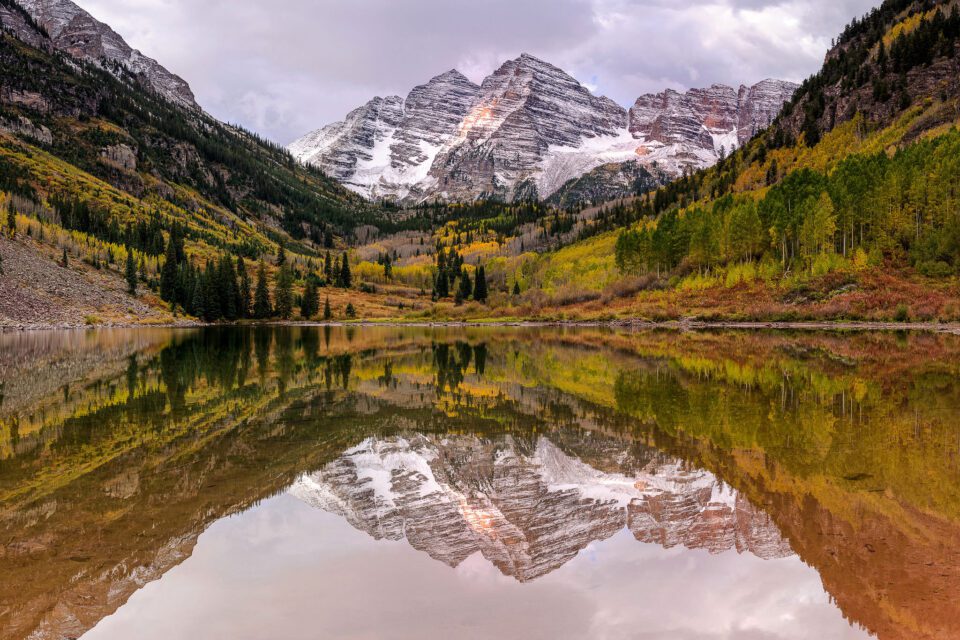 NIKON D700 + 24-70mm f/2.8 @ 44mm, ISO 200, 1/30, f/8.0لا ينطبق هذا على الخطوط البادئة فحسب، بل ينطبق أيضًا على الإطارات الموجودة على حافة الصورة. الإطارات الطبيعية ليست دائمًا مثالية أو تستحق البحث عنها بنسبة 100% من الوقت. أرى بعض المصورين يحاولون وضع غصن شجرة فوق الجزء العلوي من الصورة كلما استطاعوا، ويغلقون الصورة بالخطوط كلما أمكن ذلك. ينجح هذا أحيانًا، لكن في أحيان أخرى لا يكون للشجرة أي أهمية نظرًا لسياق بقية الصورة؛ يبدو الأمر غير صادق بطريقة أو بأخرى.
NIKON D700 + 24-70mm f/2.8 @ 44mm, ISO 200, 1/30, f/8.0لا ينطبق هذا على الخطوط البادئة فحسب، بل ينطبق أيضًا على الإطارات الموجودة على حافة الصورة. الإطارات الطبيعية ليست دائمًا مثالية أو تستحق البحث عنها بنسبة 100% من الوقت. أرى بعض المصورين يحاولون وضع غصن شجرة فوق الجزء العلوي من الصورة كلما استطاعوا، ويغلقون الصورة بالخطوط كلما أمكن ذلك. ينجح هذا أحيانًا، لكن في أحيان أخرى لا يكون للشجرة أي أهمية نظرًا لسياق بقية الصورة؛ يبدو الأمر غير صادق بطريقة أو بأخرى.لذا، إذا كنت تريد استخدام الخطوط بشكل فعال في التصوير الفوتوغرافي والتوجيه وغيره، فهذه هي الخطوات التي أنصحك باتباعها:
ابحث عن خط مثير للاهتمام واكتشف مقدار الاهتمام الذي يجذبه. تأكد من أن صورتك تستفيد من خط الاتصال وأنه ليس مجرد إلهاء. قم بتحليل عاطفة الخط، ومعرفة ما إذا كان يعمل بشكل جيد للرسالة العاطفية للخط. بقية الصورة قرر ما إذا كنت تريد أن يكون الخط هو موضوعك الأساسي أو عنصرًا أصغر في التركيب. لزيادة تأثير الخط، قف بالقرب منه واستخدم عدسة واسعة. إذا كان المشاهدون يميلون إلى القراءة من اليسار إلى اليمين، فقد ترغب في ذلك قم بتكوين الخط الرئيسي الخاص بك بحيث يبدأ في المقدمة على اليسار، ثم ينتقل إلى اليمين مع تقدمه في المسافة (على الرغم من أنني لست متفقًا تمامًا مع هذه الفكرة شخصيًا) انتبه إلى الآفاق وتأكد من أنها لا تفعل ذلك. حجب عين المشاهد حافظ على حواف صورتك خالية من عناصر التشتيت إن أمكن، ربما عن طريق حجبها بخطوط تركيبية مختلفة
نأمل أن تمنحك النصائح المذكورة أعلاه فكرة جيدة عن كيفية استخدام الخطوط الرائدة والخطوط التركيبية الأخرى في التصوير الفوتوغرافي!
This isn’t just true for leading lines, but also for frames at the edge of a photo. Natural frames aren’t always ideal or worth searching for 100% of the time. I see some photographers try to put a tree branch over the top of their composition whenever they can, closing off the composition with lines whenever possible. This sometimes works, but other times the tree doesn’t have any significance given the context of the rest of the image; it just looks insincere somehow.
So, if you want to use lines effectively in photography, leading and otherwise, these are the steps I recommend you follow:
- Find an interesting line and figure out how much attention it draws
- Make sure that your photo benefits from a connecting line and that it isn’t just a distraction
- Analyze the emotion of the line, and see if it works well for the emotional message of the rest of the photo
- Decide if you want the line to be your primary subject or a smaller element of composition
- To increase the impact of the line, stand close to it and use a wide lens
- If your viewers tend to read from left to right, you may wish to compose your leading line so it starts in the foreground on the left, then travels to the right as it goes into the distance (though I’m not fully on board with this idea personally)
- Pay attention to horizons and make sure they don’t block your viewer’s eye
- Keep the edges of your photo free from distractions if possible, potentially by blocking them off with various compositional lines
Hopefully, the tips above give you a good idea of how to use leading lines and other compositional lines in photography!
-

